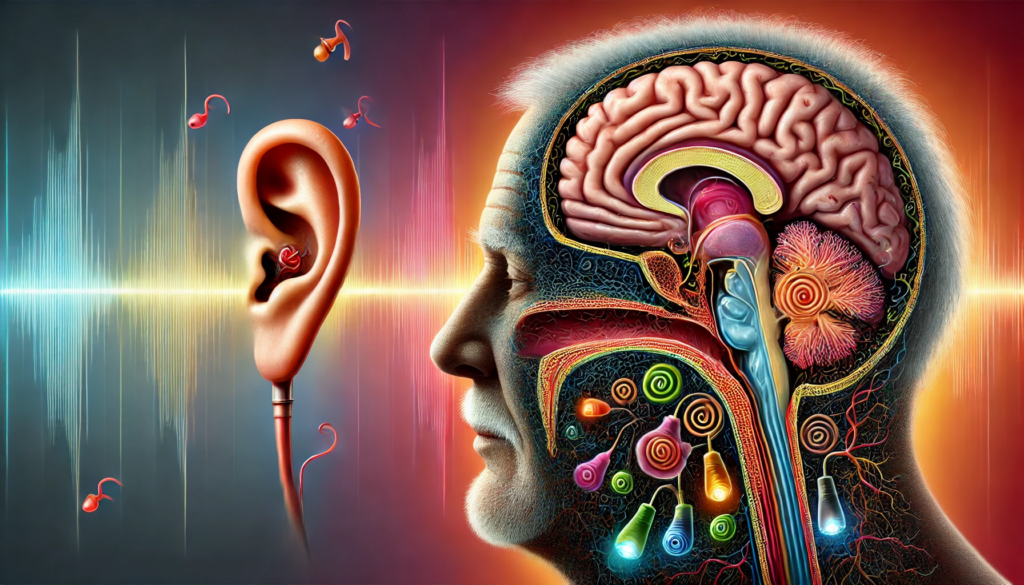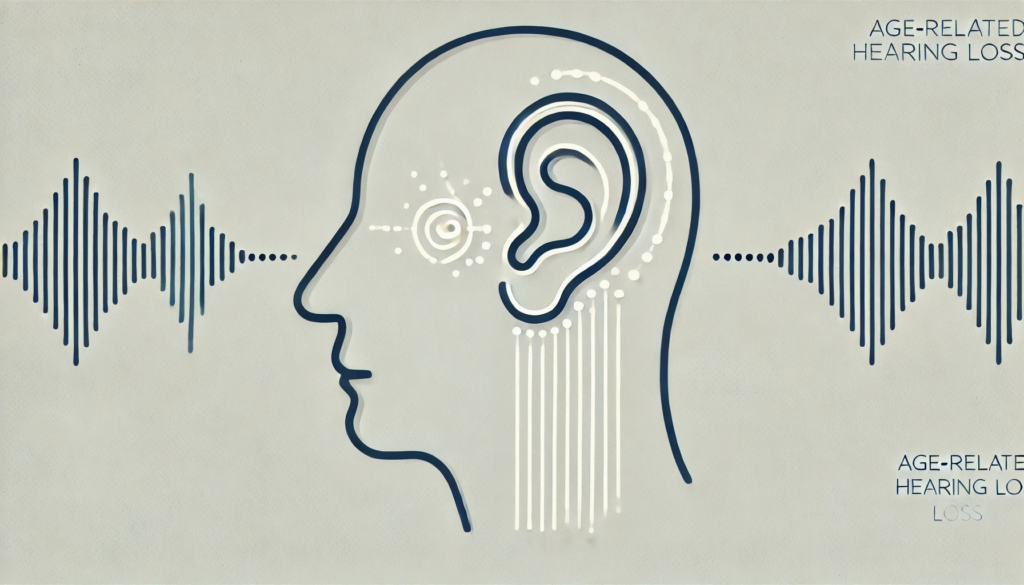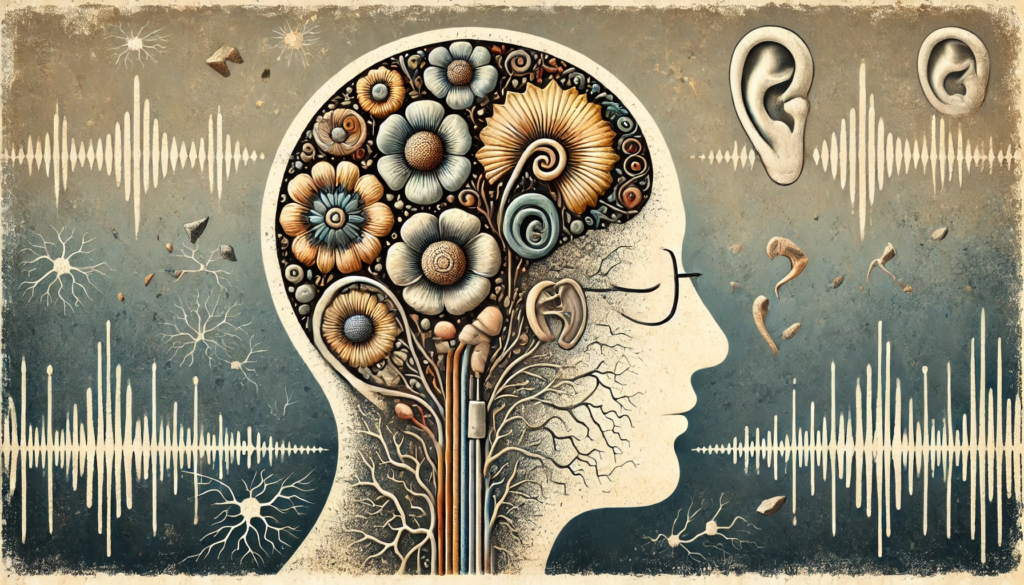
ChatGPT:
Introduction
As individuals age, it’s common for them to experience a gradual decline in hearing ability, a condition known as presbycusis or age-related hearing loss. From a neuroscience perspective, this process involves complex changes at multiple levels of the auditory system, including the peripheral structures of the ear, the auditory nerve, and the central auditory pathways in the brain. Understanding these changes provides insight into why hearing loss occurs with age and how it affects the neural processing of sound.
Peripheral Auditory Changes
1. Hair Cell Degeneration: The cochlea, a spiral-shaped organ in the inner ear, contains two types of hair cells—inner and outer hair cells—that are essential for hearing. With age, these hair cells can degenerate due to factors like cumulative noise exposure, oxidative stress, and metabolic changes. Outer hair cells are particularly vulnerable and their loss leads to decreased sensitivity and frequency selectivity, especially for high-frequency sounds.
2. Stria Vascularis Atrophy: The stria vascularis is a part of the cochlea responsible for maintaining the ionic composition of the endolymph fluid, which is crucial for hair cell function. Age-related atrophy of the stria vascularis can disrupt this ionic balance, impairing hair cell function and leading to hearing loss.
3. Basilar Membrane Stiffening: The mechanical properties of the basilar membrane, which supports the hair cells, can change with age. Increased stiffness of this membrane can alter the way sound waves are transmitted within the cochlea, affecting the tuning and sensitivity of hair cells.
Neural Auditory Changes
1. Spiral Ganglion Neuron Loss: The spiral ganglion neurons transmit auditory information from the hair cells to the brain via the auditory nerve. Aging can lead to the loss of these neurons, reducing the fidelity of neural signals reaching the central auditory system.
2. Synaptic Degeneration: The synapses between hair cells and spiral ganglion neurons can degenerate over time. This synaptopathy affects the transmission of auditory signals, particularly in noisy environments where precise timing of neural firing is essential.
3. Auditory Nerve Degeneration: The myelination of auditory nerve fibers can deteriorate with age, leading to slower transmission speeds and decreased temporal resolution. This can make it difficult for seniors to process rapid changes in sound, such as speech cues.
Central Auditory Processing Changes
1. Neurotransmitter Imbalance: Aging can disrupt the balance of excitatory and inhibitory neurotransmitters in the auditory pathways of the brain. Changes in neurotransmitter levels, such as glutamate and GABA, can affect neural plasticity and the ability to adapt to auditory inputs.
2. Cortical Reorganization: The auditory cortex may undergo structural and functional changes with age. There can be a reduction in cortical thickness, neuron density, and synaptic connections. These changes can impair higher-order processing of complex sounds, like speech and music.
3. Cognitive Load Increase: Seniors often require more cognitive resources to process auditory information due to decreased neural efficiency. This increased cognitive load can exacerbate difficulties in understanding speech, especially in challenging listening environments.
Molecular and Cellular Mechanisms
1. Oxidative Stress: Accumulation of reactive oxygen species can damage cellular components in the auditory system. Mitochondrial dysfunction in auditory neurons and hair cells contributes to their degeneration.
2. Inflammation: Chronic inflammation can promote neural damage. Inflammatory markers have been found to be elevated in the auditory pathways of aged individuals.
3. Genetic Factors: Certain genes associated with aging processes can influence susceptibility to hearing loss. Genetic predispositions can affect the rate of cellular aging in the auditory system.
Impact on Neural Plasticity
While the brain has the ability to reorganize itself—a property known as neural plasticity—this capacity diminishes with age. The reduced plasticity in the auditory cortex and related pathways limits the ability to compensate for peripheral hearing loss. This can lead to persistent auditory deficits even if peripheral function is partially restored through interventions like hearing aids.
Interrelation with Other Neural Systems
Age-related hearing loss doesn’t occur in isolation. It can interact with other neural changes associated with aging, such as declines in memory and attention systems. Hearing loss can lead to social isolation, which is a risk factor for cognitive decline and neurodegenerative diseases like Alzheimer’s disease.
Potential Interventions
Understanding the neuroscience behind age-related hearing loss opens avenues for interventions:
1. Pharmacological Approaches: Antioxidants and anti-inflammatory agents may help protect auditory neurons and hair cells from age-related damage.
2. Neural Prosthetics: Cochlear implants can bypass damaged hair cells by directly stimulating the auditory nerve, but their effectiveness can be limited by central auditory processing deficits.
3. Auditory Training: Engaging in activities that stimulate auditory processing can promote neural plasticity and potentially mitigate some central auditory deficits.
Conclusion
Age-related hearing loss in seniors is a multifaceted process involving peripheral and central changes in the auditory system. From the degeneration of hair cells and neurons to alterations in neurotransmitter levels and cortical processing, the neuroscience of hearing loss highlights the complexity of auditory aging. Continued research in this field is essential for developing effective strategies to preserve hearing and maintain quality of life for aging individuals.

Introduction
Age-related hearing loss, known as presbycusis, is a gradual decline in hearing ability that occurs as part of the natural aging process. It predominantly affects high-frequency hearing and can impact the ability to understand speech, especially in noisy environments. Understanding the usual rates of hearing loss during healthy aging helps in setting expectations and planning for interventions when necessary.
Typical Rates of Hearing Loss in Healthy Aging
1. Progressive Nature of Hearing Loss
• Gradual Decline: Hearing loss in aging adults is typically gradual, occurring over decades.
• Symmetrical Loss: It usually affects both ears equally.
2. Frequency-Specific Hearing Loss
• High Frequencies (Above 2000 Hz):
• Early Impact: High-frequency hearing is often the first to decline.
• Rate of Loss: On average, there is a threshold increase of about 1 dB per year starting from middle age.
• Cumulative Effect: By age 65, individuals may experience a loss of 30–40 dB at frequencies above 4000 Hz.
• Mid to Low Frequencies (Below 2000 Hz):
• Slower Decline: Hearing sensitivity at mid to low frequencies declines more slowly.
• Rate of Loss: Threshold increases are typically less than 0.5 dB per year.
• Minimal Impact Until Advanced Age: Significant losses at these frequencies may not occur until after age 70.
3. Age-Related Threshold Shifts
• Per Decade Changes:
• Ages 20–30: Minimal to no significant hearing loss; thresholds remain near 0 dB HL (hearing level).
• Ages 40–50: High-frequency thresholds may increase by 10–15 dB.
• Ages 60–70: High-frequency thresholds can increase by 30–40 dB; mid-frequency thresholds may begin to show a 10–20 dB loss.
• Ages 80 and Above: High-frequency losses may exceed 50 dB; mid-frequency losses can be 20–30 dB; low-frequency losses may become noticeable.
4. Gender Differences
• Men:
• Higher Rates of Loss: Generally experience greater hearing loss at earlier ages, particularly at high frequencies.
• Noise Exposure Factor: Occupational and recreational noise exposure contributes to accelerated loss.
• Women:
• Slower Progression: Tend to have less severe hearing loss until advanced ages.
• Frequency Pattern: May experience more loss at lower frequencies in very old age compared to men.
5. Impact on Speech Understanding
• Consonant Sounds: High-frequency hearing loss affects the perception of consonants, which are crucial for speech clarity.
• Speech-in-Noise Difficulty: Understanding speech in noisy environments becomes increasingly challenging due to reduced auditory processing.
Factors Influencing Hearing Loss Rates
1. Genetics
• Hereditary Factors: Genetic predisposition significantly affects individual rates of hearing decline.
2. Environmental Exposure
• Noise-Induced Damage: Lifelong exposure to loud noises can accelerate age-related hearing loss.
• Ototoxic Agents: Certain medications and chemicals can damage auditory structures.
3. Health Conditions
• Cardiovascular Disease: Can impair blood flow to the inner ear, exacerbating hearing loss.
• Diabetes Mellitus: Associated with microvascular damage affecting the cochlea.
4. Lifestyle Choices
• Smoking: Increases the risk of hearing loss due to vascular and oxidative stress.
• Diet and Exercise: Healthy habits may slow the progression of hearing decline.
Statistical Overview
1. Prevalence Rates
• Ages 65–74: Approximately 25–30% have significant hearing loss.
• Ages 75 and Older: About 50% experience disabling hearing loss.
2. Hearing Thresholds by Age Group
• Young Adults (18–25 Years):
• Normal Hearing: Thresholds at or below 20 dB HL across frequencies.
• Middle-Aged Adults (45–55 Years):
• Mild High-Frequency Loss: Thresholds may rise to 25–35 dB HL above 4000 Hz.
• Older Adults (65–75 Years):
• Moderate Loss: Thresholds can reach 40–60 dB HL at high frequencies.
• Elderly (85 Years and Above):
• Severe Loss: Thresholds may exceed 70 dB HL at high frequencies, with noticeable loss at lower frequencies.
Audiogram Patterns in Presbycusis
1. Typical Configurations
• Sloping High-Frequency Loss: The most common pattern, with thresholds worsening at higher frequencies.
• Flat Loss: Less common; uniform threshold elevation across frequencies, possibly indicating other pathologies.
2. Speech Audiometry
• Speech Reception Threshold (SRT): May remain relatively good if low-frequency hearing is preserved.
• Word Recognition Scores: Can decline significantly, especially in noisy environments.
Implications for Daily Life
1. Communication Challenges
• Difficulty Hearing Soft Sounds: Particularly consonants like “s,” “th,” and “f.”
• Misinterpretation of Words: Leading to misunderstandings.
2. Social Impact
• Withdrawal: Avoidance of social situations due to hearing difficulties.
• Emotional Effects: Frustration, embarrassment, and isolation.
Conclusion
The usual rates of hearing loss in the healthy aging process involve a gradual increase in hearing thresholds, especially at higher frequencies. While the average rates provide a general understanding, individual experiences can vary widely based on genetics, environmental exposures, health conditions, and lifestyle choices. Regular hearing evaluations are important for monitoring changes and implementing strategies to manage hearing loss effectively.
Recommendations
• Regular Hearing Check-ups: Starting at age 50, or earlier if symptoms occur.
• Hearing Protection: Use ear protection in noisy environments to prevent noise-induced acceleration of hearing loss.
• Healthy Lifestyle: Maintain cardiovascular health through diet and exercise.
• Early Intervention: Consider hearing aids or assistive listening devices when hearing loss begins to affect daily activities.
Final Note
Understanding the typical rates of hearing loss can help individuals anticipate changes and seek timely assistance. Advances in audiology offer various solutions to mitigate the impact of hearing loss, enhancing communication and quality of life for seniors.
******
Introduction
Slowing down the process of age-related hearing loss, known as presbycusis, is a critical concern as the global population ages. From a neuroscience perspective, interventions aim to protect the structures and functions of the auditory system, both peripheral (in the ear) and central (in the brain). Strategies to slow hearing loss involve lifestyle modifications, pharmacological interventions, protective measures, and emerging regenerative therapies. This discussion explores these possibilities, emphasizing how they address the neural mechanisms underlying hearing decline.
Lifestyle Modifications
1. Reducing Noise Exposure
• Avoid Loud Environments: Prolonged exposure to high-decibel sounds can accelerate hair cell and neuron damage. Limiting time spent in noisy places like concerts or using quieter settings can reduce this risk.
• Use Hearing Protection: When exposure to loud noise is unavoidable, earplugs or noise-canceling headphones can protect the auditory system by reducing the intensity of sound reaching the inner ear.
2. Healthy Diet and Nutrition
• Antioxidant Intake: Consuming foods rich in antioxidants (vitamins A, C, E, magnesium, and zinc) can combat oxidative stress in auditory cells.
• Folate and B Vitamins: Adequate levels of folate and B vitamins support neural health and may reduce homocysteine levels, which are associated with increased risk of hearing loss.
• Omega-3 Fatty Acids: Found in fish oil, these fatty acids have anti-inflammatory properties that may protect auditory neurons.
3. Regular Physical Activity
• Improved Circulation: Exercise enhances blood flow, delivering essential nutrients and oxygen to the cochlea and auditory pathways.
• Anti-inflammatory Effects: Physical activity can reduce systemic inflammation, potentially decreasing inflammatory damage to auditory structures.
Pharmacological Interventions
1. Antioxidant Therapies
• N-Acetylcysteine (NAC): As a precursor to glutathione, a key antioxidant, NAC may protect hair cells from oxidative damage.
• Coenzyme Q10: This antioxidant supports mitochondrial function in auditory cells, potentially reducing age-related decline.
2. Anti-inflammatory Agents
• Steroids: Corticosteroids can reduce inflammation in the auditory system, though their use must be carefully managed due to side effects.
• Non-Steroidal Anti-Inflammatory Drugs (NSAIDs): Some NSAIDs may have protective effects, but long-term use can pose risks, and some studies suggest they might increase hearing loss risk.
3. Neuroprotective Drugs
• Glutamate Antagonists: Excessive glutamate can cause excitotoxicity in auditory neurons. Antagonists may prevent this damage.
• Calcium Channel Blockers: By regulating calcium influx in neurons, these drugs might prevent cell death in the auditory pathways.
4. Hormonal Treatments
• Estrogen Therapy: Postmenopausal estrogen therapy has been studied for its potential protective effects on hearing, though results are mixed and require careful consideration of risks and benefits.
Hearing Protection Strategies
1. Early Use of Hearing Aids
• Auditory Stimulation: Using hearing aids can prevent auditory deprivation by maintaining neural activity in auditory pathways, potentially slowing central processing decline.
• Customized Fitting: Properly fitted hearing aids ensure optimal amplification without overexposure to loud sounds.
2. Assistive Listening Devices
• Personal Amplifiers: These devices can enhance sound in specific settings, reducing strain on the auditory system.
• Loop Systems and FM Systems: These technologies improve signal-to-noise ratio, aiding in clearer sound transmission to the listener.
Auditory Training and Cognitive Exercises
1. Auditory Rehabilitation
• Listening Exercises: Programs that focus on distinguishing sounds and speech in noise can enhance auditory processing capabilities.
• Speech Reading: Learning to read lips and facial expressions can supplement auditory information, easing communication.
2. Musical Training
• Instrument Learning: Playing an instrument stimulates auditory and motor pathways, promoting neural plasticity.
• Music Appreciation: Active engagement with music can improve temporal processing and auditory discrimination skills.
3. Cognitive Training
• Memory and Attention Enhancement: Exercises that strengthen cognitive functions support the processing of complex auditory information.
Emerging Research and Regenerative Therapies
1. Hair Cell Regeneration
• Gene Therapy: Introducing genes that promote hair cell growth, such as Atoh1, into the cochlea is a promising area of research.
• Stem Cell Therapy: Transplanting stem cells that can differentiate into hair cells or supporting cells may restore auditory function.
2. Synaptopathy Repair
• Neurotrophin Delivery: Administering neurotrophic factors like BDNF may help regenerate synapses between hair cells and spiral ganglion neurons.
• Pharmacological Agents: Compounds that promote synaptic repair are under investigation for their potential to reverse hidden hearing loss.
3. Anti-Apoptotic Agents
• Caspase Inhibitors: By blocking apoptosis pathways, these agents may prevent hair cell and neuron death.
• Heat Shock Proteins: Enhancing the expression of protective proteins could help cells withstand stressors that lead to degeneration.
Addressing Comorbid Conditions
1. Cardiovascular Health
• Blood Pressure Control: Hypertension can affect cochlear blood flow. Managing blood pressure supports auditory health.
• Cholesterol Management: High cholesterol can contribute to vascular problems in the ear; statins and lifestyle changes may help.
2. Diabetes Management
• Glycemic Control: Diabetes can damage blood vessels and nerves, including those in the auditory system. Tight glucose control reduces this risk.
3. Smoking and Alcohol Use
• Smoking Cessation: Quitting smoking decreases exposure to toxins that damage auditory cells.
• Moderate Alcohol Consumption: Excessive alcohol can harm auditory pathways; moderation is key.
Genetic Research and Personalized Medicine
1. Genetic Screening and Counseling
• Risk Assessment: Identifying genetic predispositions allows for early interventions tailored to individual risk profiles.
2. Epigenetic Modulation
• Environmental Influences: Understanding how lifestyle factors affect gene expression related to hearing can guide preventive strategies.
3. Pharmacogenomics
• Customized Treatments: Medications can be selected based on genetic factors that influence drug metabolism and efficacy.
Neural Plasticity Enhancement
1. Transcranial Magnetic Stimulation (TMS)
• Cortical Stimulation: TMS may enhance neural activity in auditory cortices, promoting plasticity and functional improvements.
2. Cognitive Behavioral Therapy (CBT)
• Tinnitus Management: CBT can help manage tinnitus, which often accompanies hearing loss, reducing its impact on auditory processing.
Conclusion
Slowing down age-related hearing loss is a multifaceted challenge that requires a comprehensive approach targeting the peripheral and central auditory systems. Lifestyle modifications play a crucial role in reducing risk factors and supporting overall neural health. Pharmacological interventions offer potential protective effects at the cellular and molecular levels. Protective strategies, including the early use of hearing aids and auditory training, help maintain neural activity and plasticity in auditory pathways. Emerging regenerative therapies hold promise for reversing damage, although they are still under investigation.
By addressing the underlying neuroscience of hearing loss, these strategies aim to preserve auditory function, enhance communication abilities, and improve the quality of life for aging individuals. Collaboration between patients, healthcare providers, and researchers is essential to implement these interventions effectively and to continue advancing our understanding of auditory aging.
Recommendations
• Regular Hearing Evaluations: Early detection enables timely interventions to slow progression.
• Protect Hearing: Use ear protection in noisy environments and avoid unnecessary exposure to loud sounds.
• Healthy Lifestyle: Adopt a diet rich in antioxidants, maintain physical activity, and manage chronic health conditions.
• Stay Engaged: Participate in social activities, auditory training, and cognitive exercises to promote neural health.
• Consult Professionals: Work with audiologists and healthcare providers to develop personalized hearing conservation plans.
Future Directions
Ongoing research aims to better understand the mechanisms of age-related hearing loss and to develop novel interventions. Advances in gene therapy, stem cell research, and neuropharmacology may offer new avenues for prevention and treatment. Public health initiatives focusing on education and early intervention can further support efforts to slow the progression of hearing loss in seniors.
By integrating current knowledge with emerging technologies, there is hope for more effective strategies to preserve hearing and enhance the well-being of aging populations.

